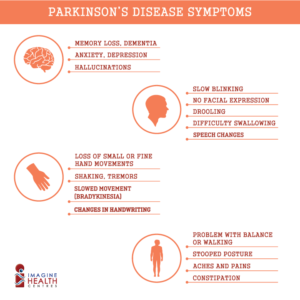Symptoms of Parkinson’s Disease
Early signs may be mild and may go unnoticed. Symptoms often begin on one side of your body and usually remain worse on that side, even after symptoms begin to affect both sides.
Parkinson’s signs and symptoms may include:
-
Tremor – A tremor, or shaking, usually begins in a limb, often your hand or fingers. You may notice a back-and-forth rubbing of your thumb and forefinger, known as a pill-rolling tremor. One characteristic of Parkinson’s disease is a tremor of your hand when it is relaxed (at rest).
-
Slowed movement (bradykinesia) – Over time, Parkinson’s disease may reduce your ability to move and slow your movement, making simple tasks difficult and time-consuming. Your steps may become shorter when you walk, or you may find it difficult to get out of a chair. Also, you may drag your feet as you try to walk, making it difficult to move.
-
Rigid muscles – Muscle stiffness may occur in any part of your body. The stiff muscles can limit your range of motion and cause you pain.
-
Impaired posture and balance – Your posture may become stooped, or you may have balance problems as a result of Parkinson’s disease.
-
Loss of automatic movements – In Parkinson’s disease, you may have a decreased ability to perform unconscious movements, including blinking, smiling or swinging your arms when you walk.
-
Speech changes – You may have speech problems as a result of Parkinson’s disease. You may speak softly, quickly, slur or hesitate before talking. Your speech may be more of a monotone rather than with the usual inflections.
-
Writing changes – It may become hard to write, and your writing may appear small
Content courtesy the Mayo Clinic website

